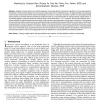261 search results - page 51 / 53 » Unavoidable sequences in constructive analysis |
BMCBI
2007
15 years 16 days ago
2007
Background: Maximum parsimony phylogenetic tree reconstruction from genetic variation data is a fundamental problem in computational genetics with many practical applications in p...
117
click to vote
PAMI
2006
15 years 10 days ago
2006
Analysis of motion patterns is an effective approach for anomaly detection and behavior prediction. Current approaches for the analysis of motion patterns depend on known scenes, w...
119
click to vote
BMCBI
2002
15 years 7 days ago
2002
Background: DNA microarray technology is a powerful technique that was recently developed in order to analyze thousands of genes in a short time. Presently, microarrays, or chips,...
109
Voted
COMPGEOM
2010
ACM
15 years 5 months ago
2010
ACM
We present a simple randomized scheme for triangulating a set P of n points in the plane, and construct a kinetic data structure which maintains the triangulation as the points of...
81
Voted
EUSFLAT
2003
15 years 1 months ago
2003
In 1931 and 1935, Ernst Adolph Guillemin, professor of electrical engineering at Masachusetts Institute of Technology (MIT), published the two volumes of his book “Communication...

